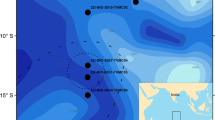Abstract
The metazoan meiofauna in the Chukchi Sea were collected from seven shallow water stations (depths ranging 46 to 52 m) and five deep sea stations (depths ranging between 393 and 2 300 m) during the 4th Chinese National Arctic Research Expedition in 2010. The results showed that abundance of meiofauna was higher in shallow water sediments (average of 2 445 ind./(10 cm2)) than in deep sea sediments (407.06 ind./(10 cm2)). A UNIANOVA test for difference between the two different regions was highly significant (F=101.15, p<0.01). Nematodes were numerically dominant, representing (96.6±4.6)% of the total meiofaunal abundance at the shallow water stations and (98.90±1.42)% at deep sea stations. The number of higher taxonomic groups and abundance of meiofauna were higher at Stas CC1, CC4, and R06 near the Bering Strait and the continent, than at the rest of the shallow water and deep sea stations. The primary factors causing the differences were concentrations of nutrients P and Si of bottom seawater (R=0.831, p<0.003), followed by depth (R=−0.655, p<0.05) and sand fractions of sediments (R=0.632, p <0.05). The numbers of meiofauna on the 65 μm and 32 μm sieves were significantly higher than those on the rest of the screens. Differences in numbers of meiofauna retained on screens with different mesh openings were highly significant among all sampling stations (F=31.60, p<0.01). The highest numbers of individuals on screens with 32 μm mesh openings were found at deep sea stations. The number of meiofauna in the top 0–1, 1–2, and 2–4 cm segments constituted 84.4% of the total and was significantly higher than those in the bottom 4–6 and 6–10 cm segments (F=15, p<0.01).
Similar content being viewed by others
References
Bessiere A, Nozais C, Brugel S, et al. 2007. Metazoan meiofauna dynamics and pelagic-benthic coupling in the Southeastern Beaufort Sea, Arctic Ocean. Polar Biology, 30(9): 1123–1135
Callaghan T V, Johansson M, Prowse T D, et al. 2011. Arctic cryosphere: changes and impacts. AMBIO, 401: 3–5
Chen Liqi, et al. 2003. Marine Environment and Air-Sea Interaction in the Arctic Region (in Chinese). Beijing: China Ocean Press
Gambi C, Vanreusel A, Danovaro R. 2003. Biodiversity of nematode assemblages from deep-sea sediments of the Atacama Slope and Trench (South Pacific Ocean). Deep-Sea Research Part I: Oceanographic Research Papers, 50(1): 103–117
Giere O. 2009. Meiobenthology: the Microscopic Motile Fauna of Aquatic Sediments. Berlin: Springer Berlin Heidelberg
Gray J S. 1981. The Ecology of Marine Sediments: An Introduction to the Structure and Function of Benthic Communities. Cambridge: Cambridge University Press
Grebmeier J M. 1993. Studies of pelagic benthic coupling extended onto the Soviet Continental-Shelf in the northern Bering and Chukchi Seas. Continental Shelf Research, 13(5–6): 653–668
Gutzmann E, Arbizu P M, Rose A, et al. 2004. Meiofauna communities along an abyssal depth gradient in the Drake Passage. Deep-Sea Research Part II: Topical Studies in Oceanography, 51(14–16): 1617–1628
Heip C, Vincx M, Vranken G. 1985. The ecology of marine nematodes. Oceanography and Marine Biology, 23: 399–489
Herman R L, Dahms H U. 1992. Meiofauna communities along a depth transect off halley bay (Weddell Sea-Antarctica). Polar Biology, 12(2): 313–320
Hoste E, Vanhove S, Schewe I, et al. 2007. Spatial and temporal variations in deep-sea meiofauna assemblages in the Marginal Ice Zone of the Arctic Ocean. Deep-Sea Research Part I: Oceanographic Research Papers, 54(1): 109–129
Piepenburg D. 2005. Recent research on Arctic benthos: common notions need to be revised. Polar Biology, 28(10): 733–755
Renaud P E, Ambrose W G, Vanreusel A, et al. 2006. Nematode and macrofaunal diversity in central Arctic Ocean benthos. Journal of Experimental Marine Biology and Ecology, 330(1): 297–306
Rex M A, Etter R J, Morris J S, et al. 2006. Global bathymetric patterns of standing stock and body size in the deep-sea benthos. Marine Ecology Progress Series, 317: 1–8
Shirayama Y. 1984. The abundance of deep sea meiobenthos in the Western Pacifie in relation to environmeiltal factors. Oceanologica Acta, 7(1): 113–121
Soetaert K, Heip C. 1995. Nematode assemblages of deep-sea and shelf break sites in the North-Atlantic and Mediterranean-Sea. Marine Ecology Progress Series, 125(1–3): 171–183
Soltwedel T, Portnova D, Kolar I, et al. 2005. The small-sized benthic biota of the Hakon Mosby Mud Volcano (SW Barents Sea slope). Journal of Marine Systems, 55(3–4): 271–290
Tietjen J H. 1984. Distribution and species-diversity of deep-sea nematodes in the Venezuela Basin. Deep-Sea Research Part A: Oceanographic Research Papers, 31(2): 119–132
Vanaverbeke J, Arbizu P M, Dahms H U, et al. 1997. The metazoan meiobenthos along a depth gradient in the Arctic Laptev Sea with special attention to nematode communities. Polar Biology, 18(6): 391–401
Vermeeren H, Vanreusel A, Vanhove S. 2004. Species distribution within the free-living marine nematode genus Dichromadora in the Weddell Sea and adjacent areas. Deep-Sea Research Part II: Topical Studies in Oceanography, 51(14–16): 1643–1664
Vernberg F J, Vernberg W B. 1981. Functional Adaptations of Marine Organisms. New York: Academic Press
Vincx M, Bett B J, Dinet A, et al. 1994. Meiobenthos of the deep Northeast Atlantic. Advances in Marine Biology, 30: 1–88
Yu Xingguang. 2011. The Report of 2010 Chinese Arctic Research Expedition (in Chinese). Beijing: China Ocean Press P. 95–102
Author information
Authors and Affiliations
Corresponding author
Additional information
Foundation item: The Chinese Polar Environment Comprehensive Investigation and Assessment Programs under contract No. CHINARE2012-03-05; the Ocean Public Welfare Scientific Research Project of China under contract No. 201105022-2; the Polar Science Strategic Research Foundation of China under contract No. 20120105.
Rights and permissions
About this article
Cite this article
Lin, R., Huang, D., Guo, Y. et al. Abundance and distribution of meiofauna in the Chukchi Sea. Acta Oceanol. Sin. 33, 90–94 (2014). https://doi.org/10.1007/s13131-014-0493-7
Received:
Accepted:
Published:
Issue Date:
DOI: https://doi.org/10.1007/s13131-014-0493-7




